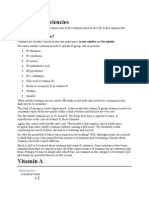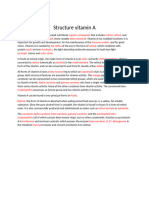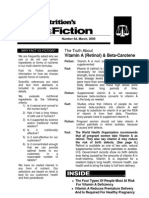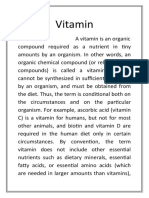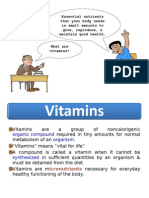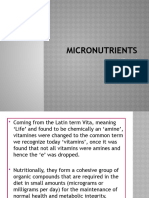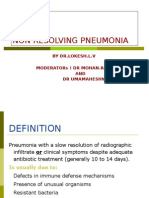Vitamins
Vitamins
Uploaded by
bhavadyaCopyright:
Available Formats
Vitamins
Vitamins
Uploaded by
bhavadyaCopyright
Available Formats
Share this document
Did you find this document useful?
Is this content inappropriate?
Copyright:
Available Formats
Vitamins
Vitamins
Uploaded by
bhavadyaCopyright:
Available Formats
Vitamin A Acetate Riboflavin Vitamin B2 Pyridoxine hydrochloride Vitamin B6 Sodium Ascorbate as ascorbic acid - Vitamin C Folic acid Vitamin
min B9 Q9. What's the difference between a milligram (mg), microgram (mcg), and an IU? A9: As metric units of measurement to quantify mass, 1000 micrograms (mcg) equal 1 milligram (mg). An IU (International Unit) is a unit of measurement for vitamins and other specific biologically active substances. The precise definition of one IU differs from substance to substance and is established by international agreement for each substance. There is no equivalence among different substances; for instance, one IU of vitamin E does not contain the same number of milligrams as one IU of vitamin A. For example, vitamin E exists in a number of different forms having different biological activities. Rather than specifying the precise type and mass of vitamin E in a preparation, the Supplement Facts label specifies the number of International Units of vitamin E. The mass equivalents of 1 IU for selected vitamins are: Vitamin A: 1 IU is the biological equivalent of 0.3 g retinol, or of 0.6 g beta-carotene Vitamin D: 1 IU is the biological equivalent of 0.025 g cholecalciferol/ergocalciferol
Vitamin E: 1 IU is the biological equivalent of 2/3 mg (0.667) d-alphatocopherol, or of 1 mg of dl-alpha-tocopherol acetate
11: VITAMIN A
Some foods contain both vitamin A itself, and other substances that can be converted to vitamin A, known as provitamin A, vitamin A precursors or carotenoids . Although it is possible to have a toxic amount of preformed vitamin A, this appears not to be the case with provitamin A, so that it is clearly safer to have more of the latter. Vitamin A is a fat-soluble vitamin, as also are vitamins D, E and K. It is therefore necessary to have some fat in the diet for these vitamins to be adequately absorbed.
One of the most important consequences of vitamin A deficiency is dryness of the eyes eventually leading to blindness. It remains one of the main causes of blindness in the world. Night blindness is also an eye complication of early vitamin A deficiency.
UNITS OF VITAMIN A CONTENT
The units for expressing the amount of vitamin A have changed from time to time because of the need to consider both preformed vitamin A (called retinol) and provitamin A (a group of components called carotenoids, of which beta-carotene is the most active and the most important). The present custom is to express the total amount of vitamin A activity as equivalent to so many micrograms of retinol. But some vitamin preparations may express the amount of vitamin A in different ways, so to help you compare these a list of conversion factors are given below: 1 retinol equivalent = 1 microgram retinol = 6 micrograms beta-carotene = 12 micrograms of other provitamin A carotenoids. The original system using international units (IU) was different, so: 1 retinol equivalent = 3.33 I-U vitamin A activity from retinol = 10 IU vitamin A activity from beta-carotene.
VITAMIN A INTAKE Recommended dietary intake of vitamin A for adults (Australia):
750 micrograms of retinol equivalents per day. For children and lactating women, see the table of recommended intakes shown in Figure 7.
Toxic levels of intake:
Children - greater than 3000 micrograms retinol equivalents per day Adults - greater than 15 000 micrograms retinol equivalents per day
Vitamin A is a vitamin that is needed by the retina of the eye in the form of a specific metabolite, the light-absorbing molecule retinal, that is absolutely necessary for both lowlight (scotopic vision) and color vision. Vitamin A also functions in a very different role, as an irreversibly oxidized form of retinol known as retinoic acid, which is an important hormone-like growth factor for epithelial and other cells. In foods of animal origin, the major form of vitamin A is an ester, primarily retinyl palmitate, which is converted to the retinol (chemically an alcohol) in the small intestine. The retinol form functions as a storage form of the vitamin, and can be converted to and from its visually active aldehyde form, retinal. The associated acid (retinoic acid), a metabolite that can be irreversibly synthesized from vitamin A, has only partial vitamin A activity, and does not function in the retina for the visual cycle. All forms of vitamin A have a beta-ionone ring to which an isoprenoid chain is attached, called a retinyl group. Both structural features are essential for vitamin activity.[1] The orange pigment of carrots beta-carotene can be represented as two connected retinyl groups, which are used in the body to contribute to vitamin A levels. Alpha-carotene and gamma-carotene also have a single retinyl group, which give them some vitamin activity. None of the other carotenes have vitamin activity. The carotenoid beta-cryptoxanthin possesses an ionone group and has vitamin activity in humans. Vitamin A can be found in two principal forms in foods:
Retinol, the form of vitamin A absorbed when eating animal food sources, is a yellow, fat-soluble substance. Since the pure alcohol form is unstable, the vitamin is found in tissues in a form of retinyl ester. It is also commercially produced and administered as esters such as retinyl acetate or palmitate. The carotenes alpha-carotene, beta-carotene, gamma-carotene; and the xanthophyll beta-cryptoxanthin (all of which contain beta-ionone rings), but no other carotenoids, function as vitamin A in herbivores and omnivore animals, which possess the enzyme required to convert these compounds to retinal. In general, carnivores are poor converters of ionine-containing carotenoids, and pure carnivores such as cats and ferrets lack beta-carotene 15,15'-monooxygenase and cannot convert any carotenoids to retinal (resulting in none of the carotenoids being forms of vitamin A for these species).
History
The discovery of vitamin A may have stemmed from research dating back to 1906, indicating that factors other than carbohydrates, proteins, and fats were necessary to keep cattle healthy.[2] By 1917 one of these substances was independently discovered by Elmer McCollum at the University of WisconsinMadison, and Lafayette Mendel and Thomas Burr Osborne at Yale University. Since "water-soluble factor B" (vitamin B) had recently been discovered, the researchers chose the name "fat-soluble factor A" (vitamin A).[2] In 1919, Steenbock (University of Wisconsin) proposed a relationship between yellow plant
pigments (beta-carotene) and vitamin A. Vitamin A was first synthesized in 1947 by two Dutch chemists, David Adriaan van Dorp and Jozef Ferdinand Arens.
[edit] Equivalencies of retinoids and carotenoids (IU)
As some carotenoids can be converted into vitamin A, attempts have been made to determine how much of them in the diet is equivalent to a particular amount of retinol, so that comparisons can be made of the benefit of different foods. The situation can be confusing because the accepted equivalences have changed. For many years, a system of equivalencies in which an international unit (IU) was equal to 0.3 g of retinol, 0.6 g of -carotene, or 1.2 g of other provitamin-A carotenoids was used.[3] Later, a unit called retinol equivalent (RE) was introduced. Prior to 2001, one RE corresponded to 1 g retinol, 2 g -carotene dissolved in oil (it is only partly dissolved in most supplement pills, due to very poor solubility in any medium), 6 g -carotene in normal food (because it is not absorbed as well as when in oils), and 12 g of either -carotene, carotene, or -cryptoxanthin in food. Newer research has shown that the absorption of provitamin-A carotenoids is only half as much as previously thought. As a result, in 2001 the US Institute of Medicine recommended a new unit, the retinol activity equivalent (RAE). Each g RAE corresponds to 1 g retinol, 2 g of -carotene in oil, 12 g of "dietary" beta-carotene, or 24 g of the three other dietary provitamin-A carotenoids.[4] Substance and its chemical environment retinol beta-carotene, dissolved in oil beta-carotene, common dietary alpha-carotene, common dietary gamma-carotene, common dietary beta-cryptoxanthin, common dietary Micrograms of retinol equivalent per microgram of the substance 1 1/2 1/12 1/24 1/24 1/24
Because the conversion of retinol from provitamin carotenoids by the human body is actively regulated by the amount of retinol available to the body, the conversions apply strictly only for vitamin A-deficient humans. The absorption of provitamins depends greatly on the amount of lipids ingested with the provitamin; lipids increase the uptake of the provitamin.[5] The conclusion that can be drawn from the newer research is that fruits and vegetables are not as useful for obtaining vitamin A as was thought; in other words, the IUs that these foods were reported to contain were worth much less than the same number of IUs of fat-dissolved oils and (to some extent) supplements. This is important for vegetarians, as Night blindness is prevalent in countries where little meat or vitamin A-fortified foods are available.
A sample vegan diet for one day that provides sufficient vitamin A has been published by the Food and Nutrition Board (page 120[4]). On the other hand, reference values for retinol or its equivalents, provided by the National Academy of Sciences, have decreased. The RDA (for men) of 1968 was 5000 IU (1500 g retinol). In 1974, the RDA was set to 1000 RE (1000 g retinol), whereas now the Dietary Reference Intake is 900 RAE (900 g or 3000 IU retinol). This is equivalent to 1800 g of -carotene supplement (3000 IU) or 10800 g of -carotene in food (18000 IU).
[edit] Recommended daily intake
Vitamin A Dietary Reference Intake[6]: RDA Life stage group Infants 06 months 712 months Children 13 years 48 years Males 913 years 1418 years 19 >70 years Females 913 years 1418 years 19 >70 years Pregnancy <19 years 19 >50 years Lactation <19 years 19 >50 years 400* 500* 300 400 600 900 900 600 700 700 750 770 1200 1300 600 600 600 900 1700 2800 3000 1700 2800 3000 2800 3000 2800 3000 Adequate intakes (AI*) g/day Upper limit g/day
(Note that the limit refers to synthetic and natural retinol ester forms of vitamin A. Carotene forms from dietary sources are not toxic.[7][8]) According to the Institute of Medicine of the National Academies, "RDAs are set to meet the needs of almost all (97 to 98%) individuals in a group. For healthy breastfed infants, the AI is the mean intake. The AI for other life stage and gender groups is believed to cover the needs of all individuals in the group, but lack of data prevents being able to specify with confidence the percentage of individuals covered by this intake."[9] To reduce the possible risk of bone fracture and osteoporosis in postmenopausal women, an upper limit intake of 1500 g RE/d has been recommended.
You might also like
- 2010-2011 Honda Insight ETM SMDocument405 pages2010-2011 Honda Insight ETM SMvikram_jhurry100% (2)
- VitaminsDocument36 pagesVitaminssreedhar9849198100% (6)
- Vitamin A WikipediaDocument10 pagesVitamin A WikipediansfanfoinNo ratings yet
- Vitamin A projectDocument6 pagesVitamin A projectjaydeemeh67.6No ratings yet
- Vitamin A (Retinol) & Beta-Carotene: The Truth AboutDocument20 pagesVitamin A (Retinol) & Beta-Carotene: The Truth AboutArinaNo ratings yet
- Nutritional Biochemistry: Vitamins Dr. Bidhan Chandra KonerDocument50 pagesNutritional Biochemistry: Vitamins Dr. Bidhan Chandra KonerElenanana100% (1)
- VitaminsDocument18 pagesVitaminsmkingyousif1No ratings yet
- Vitamins and HormonesDocument10 pagesVitamins and HormonesNooraNo ratings yet
- 5.-VITAMINSDocument49 pages5.-VITAMINSDessalegn LemmaNo ratings yet
- VitaminsDocument15 pagesVitaminsRajeswari Ranganathan100% (2)
- Vitamin ADocument40 pagesVitamin Ahuxley2378No ratings yet
- Vitamins Nutri LecDocument9 pagesVitamins Nutri LecqueenpaxtonNo ratings yet
- Vitamin A and Carotenoid Toxicity: Rune BlomhoffDocument15 pagesVitamin A and Carotenoid Toxicity: Rune BlomhoffDEEVA SKINCARENo ratings yet
- Vitamin ADocument23 pagesVitamin AAmin AksherNo ratings yet
- Nutri - Vitamins (Juji Modified)Document17 pagesNutri - Vitamins (Juji Modified)maesticeNo ratings yet
- Bioche VitaminsDocument7 pagesBioche Vitaminsharips motupalliNo ratings yet
- Vitamin_ADocument2 pagesVitamin_ADessalegn LemmaNo ratings yet
- Metabolisme Zat Gizi MikroDocument42 pagesMetabolisme Zat Gizi Mikroamalia fadhillaNo ratings yet
- Vitamins Are An Organic Chemical Compound Which The Body Requires in Small Amounts For The Metabolism and To Protect Your HealthDocument130 pagesVitamins Are An Organic Chemical Compound Which The Body Requires in Small Amounts For The Metabolism and To Protect Your HealthAneesNo ratings yet
- Vitamin A: Vitamers Retinol Argentina, Tierra de Amor y VenganzaDocument4 pagesVitamin A: Vitamers Retinol Argentina, Tierra de Amor y VenganzaDanny FentomNo ratings yet
- VitaminDocument15 pagesVitaminMonty KapoorNo ratings yet
- DT. Neelum Awan Assistant Professor Fem, Hu Lecture No.1 Micronutrients in Human Nutrition HND-613Document26 pagesDT. Neelum Awan Assistant Professor Fem, Hu Lecture No.1 Micronutrients in Human Nutrition HND-613Anas siddiquiNo ratings yet
- Vitamin A UptodateDocument11 pagesVitamin A UptodatePrasetya Ismail PermadiNo ratings yet
- Vitamin A EnglishDocument5 pagesVitamin A EnglishFika RisvitaNo ratings yet
- Vitamins and Vitamins Containing DrugsDocument26 pagesVitamins and Vitamins Containing DrugshadassahNo ratings yet
- Vitamin A - How Much Vital and Toxic To The BodyDocument4 pagesVitamin A - How Much Vital and Toxic To The BodyInternational Organization of Scientific Research (IOSR)No ratings yet
- HND-203 (Vitamin ADocument33 pagesHND-203 (Vitamin Asaeedhuda150No ratings yet
- Uas - Biokimia TeoriDocument524 pagesUas - Biokimia TeoriSri popyNo ratings yet
- Alpha CaroteneDocument25 pagesAlpha CaroteneFrietzy C FernandezNo ratings yet
- VitaminsDocument84 pagesVitaminsyewollolijfikreNo ratings yet
- Vitamin A - Health Professional Fact SheetDocument1 pageVitamin A - Health Professional Fact SheetSantiago FlorezNo ratings yet
- Jurnal Vit KDocument6 pagesJurnal Vit KTisenda TimiselaNo ratings yet
- Vitamin Part 1 (Compatibility Mode)Document44 pagesVitamin Part 1 (Compatibility Mode)tamilarasiganasanNo ratings yet
- Vitamin a and Its Related DisordersDocument33 pagesVitamin a and Its Related DisordersRoomi ChandioNo ratings yet
- VitaminsDocument100 pagesVitaminsHirut TeshaleNo ratings yet
- Vitamin ADocument23 pagesVitamin AJenny TaylorNo ratings yet
- Vitamins in Animals 150328012233 Conversion Gate01Document271 pagesVitamins in Animals 150328012233 Conversion Gate01terkaalawrenceNo ratings yet
- Vitamins and Hormones-ISC CHEMISTRY PROJECT - All About Chemistry - Reader Mode For Google Chrome™Document29 pagesVitamins and Hormones-ISC CHEMISTRY PROJECT - All About Chemistry - Reader Mode For Google Chrome™Madhav OjhaNo ratings yet
- Vitamin A FinalDocument64 pagesVitamin A FinalLiaqat HussainNo ratings yet
- Potential Use of Red Palm Oil in Combating Vitamin A Deficiency in IndiaDocument10 pagesPotential Use of Red Palm Oil in Combating Vitamin A Deficiency in IndiaNi Made Candra GusatyanaNo ratings yet
- Multi-VitaminsDocument16 pagesMulti-VitaminsdvagomaskanNo ratings yet
- 1 s2.0 S0026265X21008778 MainDocument8 pages1 s2.0 S0026265X21008778 MainElena LacramioaraNo ratings yet
- Vitamins 1Document38 pagesVitamins 1Mouhcine EssalhiNo ratings yet
- Unesco - Eolss Sample Chapters: VitaminsDocument5 pagesUnesco - Eolss Sample Chapters: VitaminsKharismaNisaNo ratings yet
- Lesson - Vitamins and MineralsDocument45 pagesLesson - Vitamins and Mineralsanirudradey449No ratings yet
- Vitamins (UAP)Document120 pagesVitamins (UAP)Sujan Bose100% (1)
- Veris TOHDocument35 pagesVeris TOHtofssbiNo ratings yet
- A Presentation On: Presented byDocument67 pagesA Presentation On: Presented byOlufemi KolawoleNo ratings yet
- Chapter SixDocument162 pagesChapter SixzyanabdullahNo ratings yet
- Micronutrients, VitaminsDocument32 pagesMicronutrients, VitaminsEsdras DountioNo ratings yet
- Vitamin A: Vitamin A Is A Group of Unsaturated Nutritional OrganicDocument16 pagesVitamin A: Vitamin A Is A Group of Unsaturated Nutritional OrganicMagazin HdPNo ratings yet
- VITAMINSDocument6 pagesVITAMINSJohn Rick OrineNo ratings yet
- SCRAPBOOKDocument18 pagesSCRAPBOOKKervy Jay AgraviadorNo ratings yet
- Module Lecture-4 VitaminsDocument42 pagesModule Lecture-4 Vitaminsmalikwholesale5No ratings yet
- PIIS2590286523000526Document17 pagesPIIS2590286523000526mj1234umNo ratings yet
- 1 Relationship of VItamins FinalDocument9 pages1 Relationship of VItamins FinalRajkumar YadavNo ratings yet
- 1 Relationship of VItamins FinalDocument9 pages1 Relationship of VItamins FinalRajkumar YadavNo ratings yet
- The Power of Food: How to Use Nutrition to Transform Your HealthFrom EverandThe Power of Food: How to Use Nutrition to Transform Your HealthNo ratings yet
- Biology, Husbandry, and Reproduction of Freshwater StingraysDocument8 pagesBiology, Husbandry, and Reproduction of Freshwater StingraysaliefNo ratings yet
- Non Resolving Pneumonia: by DR - Lokesh.L.V Moderators DR Mohan - Rao AND DR UmamaheshwariDocument58 pagesNon Resolving Pneumonia: by DR - Lokesh.L.V Moderators DR Mohan - Rao AND DR Umamaheshwaridrlokesh100% (5)
- Tan Detailed LP in EPP 6 4asDocument20 pagesTan Detailed LP in EPP 6 4asShiela Mae Saladaga Tan100% (1)
- Walker Circulation and Monsoon Season in IndiaDocument7 pagesWalker Circulation and Monsoon Season in IndiaSaranyaNo ratings yet
- Hvac Equipment Hanging Detail 1: SD SDDocument1 pageHvac Equipment Hanging Detail 1: SD SDSami KhouryNo ratings yet
- ISA-Idle Speed ControlDocument6 pagesISA-Idle Speed ControlĐức HòangNo ratings yet
- AStudyofScissorLiftsUsingParameterDesign TunDocument13 pagesAStudyofScissorLiftsUsingParameterDesign Tunnam.nguyen.cokhi.k19No ratings yet
- Plant Anatomy and PhysiologyDocument55 pagesPlant Anatomy and PhysiologyGEORGIA NAHAK100% (1)
- Math Note - FACTORING WORKSHEETDocument1 pageMath Note - FACTORING WORKSHEETNesrine LaradjiNo ratings yet
- D20 Modern - Gamma World - Secrets of The AncientsDocument75 pagesD20 Modern - Gamma World - Secrets of The AncientsВладимир Савенко100% (9)
- Aedh Wishes For The Cloths of HeavenDocument4 pagesAedh Wishes For The Cloths of HeavenalmaNo ratings yet
- IELTS 03 - Listening 01 & Reading 01 - Transcripts & KeysDocument8 pagesIELTS 03 - Listening 01 & Reading 01 - Transcripts & KeysLe Hoang KhaNo ratings yet
- Q3-W1-MAPEH-MATATAGDocument97 pagesQ3-W1-MAPEH-MATATAGDaryl Jean GutierrezNo ratings yet
- Vvdi Key Tool Max ProDocument4 pagesVvdi Key Tool Max Proinfo100% (2)
- NFPA 101 Essentials Training Module 1Document8 pagesNFPA 101 Essentials Training Module 1Alejo SztybelNo ratings yet
- Amd2a40+50 Panel Manual 2024-Jun-01Document78 pagesAmd2a40+50 Panel Manual 2024-Jun-01Karito DiegoNo ratings yet
- ST 30 PDFDocument2 pagesST 30 PDFafiffathin_akramNo ratings yet
- Accident PreventionDocument8 pagesAccident PreventionNieza Marie MirandaNo ratings yet
- Bam 101 FinalDocument214 pagesBam 101 Finalkhaledan.shadiNo ratings yet
- Dazzle: Digital Video Creator 150Document24 pagesDazzle: Digital Video Creator 150Rafael GomezNo ratings yet
- Astronomy Major 4-Year PlanDocument2 pagesAstronomy Major 4-Year PlanJohn Bowen BrownNo ratings yet
- 2b. Fitting Trade 27112020Document29 pages2b. Fitting Trade 27112020Jeevan MandalaNo ratings yet
- Unit3 BcaDocument73 pagesUnit3 BcaDev KaushikNo ratings yet
- Exp 9 Alcohols and PhenolsDocument21 pagesExp 9 Alcohols and Phenolsmajdkhashan999No ratings yet
- 9 Coach IET Seating Plan May 2019Document2 pages9 Coach IET Seating Plan May 2019Jonathan GridleyNo ratings yet
- Goosebumps Series 2000 09 - ArDocument45 pagesGoosebumps Series 2000 09 - ArAhmad Mujahid HuzaidiNo ratings yet
- Underground Coal MineDocument17 pagesUnderground Coal MineFavorSea Industrial Channel Limited100% (1)
- Geography Grade 6 Unit 1Document8 pagesGeography Grade 6 Unit 1Rmk JayathilakaNo ratings yet
- Unit 1 - Lesson 1 Contour IntroDocument10 pagesUnit 1 - Lesson 1 Contour Introapi-445306759No ratings yet

